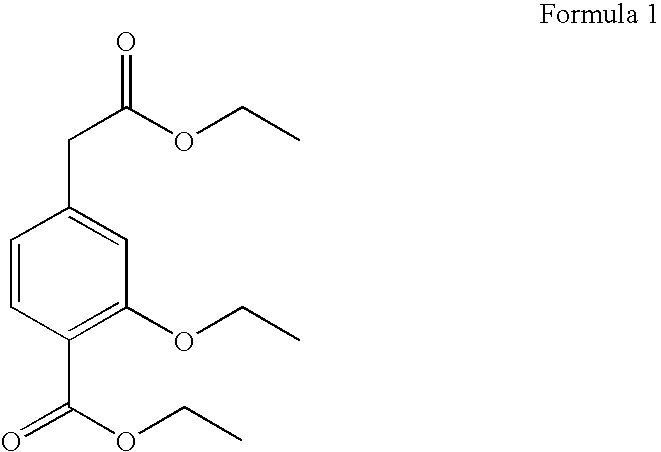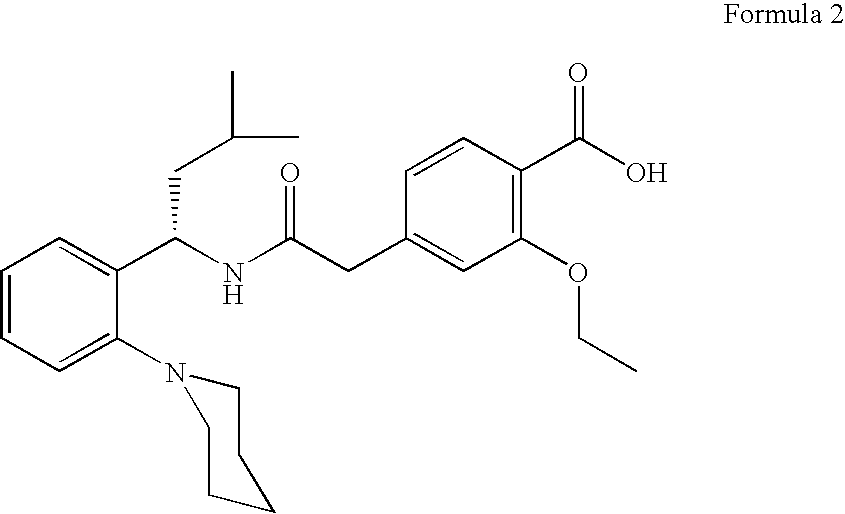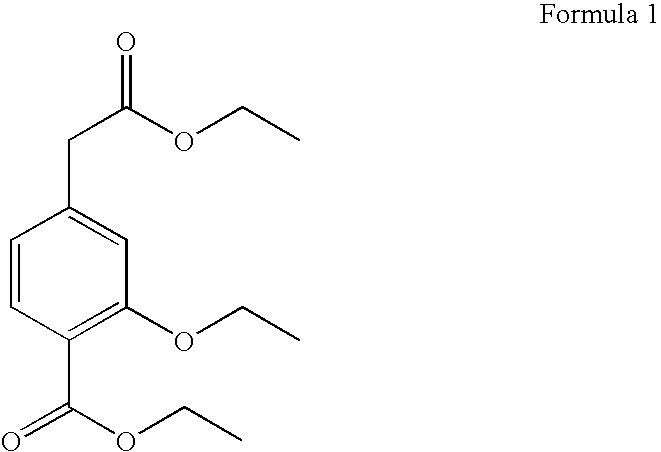Process for the preparation of ethyl 3-ethoxy-4-ethoxycarbonyl-phenylacetate
- Summary
- Abstract
- Description
- Claims
- Application Information
AI Technical Summary
Benefits of technology
Problems solved by technology
Method used
Image
Examples
example 2
[0034] 4-Methyl salicylic acid (5 g, 32.89 mmol), diethyl sulfate (20.26 g, 0.131 mole) and anhydrous potassium carbonate (18.15 g, 0.132 mole) were mixed thoroughly in dry dioxane and mixture was refluxed for 16 hr. Reaction mixture was cooled and filtered through Celite bed. Filtrate was concentrated under vacuum. Residue was purified by fractional distillation at 0.5 mm vacuum. 1st fraction distilled at 48-51.degree. C. (oil bath temperature 80.degree. C.). Product (ethyl-2-ethoxy-4-methylben-zoate) 3 distilled at 90-93.degree. C. (oil bath temperature 120.degree. C.) Yield=5.8 g (84%).
example 3
[0035] 4-Methyl salicylic acid (5 g, 32.89 mmol), diethyl sulfate (20.26 g, 0.131 mole) and anhydrous potassium carbonate (18.15 g, 0.132 mole) were mixed thoroughly in dry acetone and mixture was refluxed for 16 hr. Reaction mixture was cooled and filtered through Celite bed. Filtrate was concentrated under vacuum. Residue was purified by fractional distillation at 0.5 mm vacuum. 1st fraction distilled at 48-51.degree. C. (oil bath temperature 80.degree. C.). Product (ethyl-2-ethoxy-4-methylben-zoate) 3 distilled at 90-93.degree. C. (oil bath temperature 120.degree. C.) Yield=5.2 g (75%)
example 4
[0036] Ethyl-2-ethoxy-4-methylbenzoate (3, 5 g, 24 mmol), freshly recrystallized N-bromosuccinimide (4.7 g, 26.4 mmol), AIBN (30 mg) were mixed in dry carbon tetrachloride (25 ml). Mixture was irradiated with light using 500 W lamp and was refluxed for 12 hr. Reaction mixture was cooled to room temperature and filtered to remove succinimide. Filtrate was washed with water followed by brine wash, dried on anhydrous sodium sulfate and solvent was removed under vacuum. Residue solidifies on keeping. It was dissolved in petroleum.ether (10 ml) by refluxing. Solution was kept at room temperature for 6 hr. Product ethyl 4-bromomethyl-2-ethoxy-benzoate (4) crystallized out as yellow crystals. Cooled in ice bath and filtered. Crystals were washed with ice-cold pet ether. Dried in air.
[0037] Yield=3.5 g (50.9%). .sup.1HNMR CDCl.sub.3 (Spectrum 2) 1.45(m,6H), 4.12(q, 2H), 4.34(q, 2H), 4.46(s, 2H), 6.97(s, 1H), 6.98(d, 1H), 7.72(d, 1H). MS: (Spectrum 3) 287(12%), 286(10%), 208(14%), 161(47%), ...
PUM
| Property | Measurement | Unit |
|---|---|---|
| Time | aaaaa | aaaaa |
| Time | aaaaa | aaaaa |
| Angle | aaaaa | aaaaa |
Abstract
Description
Claims
Application Information
 Login to View More
Login to View More - R&D
- Intellectual Property
- Life Sciences
- Materials
- Tech Scout
- Unparalleled Data Quality
- Higher Quality Content
- 60% Fewer Hallucinations
Browse by: Latest US Patents, China's latest patents, Technical Efficacy Thesaurus, Application Domain, Technology Topic, Popular Technical Reports.
© 2025 PatSnap. All rights reserved.Legal|Privacy policy|Modern Slavery Act Transparency Statement|Sitemap|About US| Contact US: help@patsnap.com



